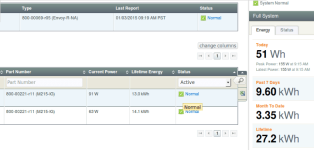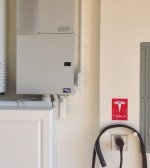I see on this thread (and elsewhere) that people want to use simple mathematics and Watt's law to compute their costs or savings on their electric bill when considering solar or anything else. I wish it were this simple but I have found this is not the case. A couple times someone has said to me something like "why change to that energy efficient bulb when you're only going to save 2 bits". Two bits being an old term for 25 cents making a new $10 LED bulb appear to have a breakeven point that's several years away. As a result, the temptation to use Ohm's law with simple math leads people to make incorrect assumptions of how much a, for example, 250 watt panel could save them.
First let me explain how I calculate my savings. While it's not perfectly accurate to the penny, it's much more accurate than anything else I've tried. I'd say "deadly accurate" since dollars don't lie. I just skip all the calculations and went to the dollar figure at the end of my bill. Then make changes in solar or electric loads at the beginning of the billing cycle and wait for the results at the end of the billing cycle. The reason I can do this has to do with where I live. Here near the coast of Northern California we have what they call a Mediterrainean climate which has low humidity and medium temperatures from late Spring through the end of Fall. Because of this, I'm fortunate to not have a need for an air conditioner. So my electric bill costs are mostly all those long term "always on" loads. As a result, my electric bill in the late 2000s was always $115 and some cents. It was uncanny because the "cents" (or pennys) would vary but the $115 never changed, ever. At least not until winter. Then I bought one of those Harbor Freight 45 watt solar systems with three 15 watt solar panels, charge controller, wiring and some 12 volt dc light bulbs etc. I added a large deep cycle battery then started moving over loads. I started with my cell phone and was shocked to open a bill that said $110 in stead of $115. I really expected maybe $114 or $115 but not $110. I added my wifes phone and a month later saw $105. I added my son's phone and saw $100. I started looking around for other easy things to hook to that battery. Keeping in mind that all electronics us DC, I connected the wireless router and saw $90 on the next bill. I continued to do this until I marched the bill to $50 and some change and this was my monthly summertime bill for the next 3 years. The only changes I made during this time was upgrading my solar to 2 used Kyrocera 125 watt panels, a mppt morningstar charge controller, and an extra battery but, this was mostly to help me through the winter. I didn't really need the upgrade for summer.
Still, this does not explain the rather large savings I was seeing. Afterall, a 5 watt cell phone charger I had even if it was plugged in 24/7 for 31 days (worst possible case) could never add up to $5.00!
5 watt charger * 24 hours * 31 days = 3720 watthours =3.72kwh
and since I was paying 13 cents per kwh: 3.72 kwh x 0.13 = 0.48 cents for the entire month and this was a worst case senario!
Now some reasons why normal math may not work on your electric bill:
1. You live in a state like California with a tiered rate structure.
If you do have a tiered rate structure, you're probably are going into the upper tiers. California has at least 4 tiers but it's not showing above because I didn't need it. The 4th tier is something like $0.45 which can run things up. If you remove a load, remember that it will alway come from your highest tier! If my cell phone displaced power from the 4th tier in the worst case senario above, I should be paying $1.67 absolute maximum. So what else can run the bill up so much?
2. A poor power factor. Power factor is a strange phenominon we usually don't have to deal with. Industrial and some commercial power users get charged extra based on their power factor (among other things like demand, etc.) As I understand it, power factor can run your bill up, usually with induction loads like motors, transformers, etc, by reflecting some of the current back to the utility which bounces back to you and will bounce back again, over and over. Each time it goes through a meter, the meter will record this as more power used yet, the power company does not generate any additional power. The utilities biggest concern is the load this places on their wiring and thus, they will require power factor corrections by the end industrial user, usually by installing the correct size capacitors in line. Resistive loads like resistance heaters and incadescent light bulbs have very good power factors so, those old light bulbs are probably not so bad on your electric bill.
3. Probably anything else that is on an industrial power user's bill that we don't see but have to be passed on to the consumer somehow. Items like "Demand" for instants. Demand is a charge for starting up any large device like a large industrial motor. Starting something like a motor requires a large, maybe like 20 times it's normal full load curent draw. A large enough motor will briefly drop the line voltage until the motor gets up to speed and the utility wants to be paid for it. There are other items too. Maybe as much as a dozen more. An industrial or commercial customer's electric bill is interesting to see.
So go ahead and try that solar system whether it's a full blown grid tied, commercially installed system or a small Harbor Freight 12vdc system. I'm sure you'll save some money. And it will be in the mucho dollars for sure.






